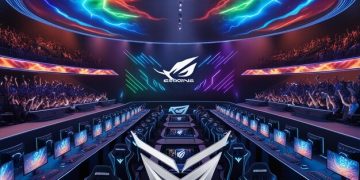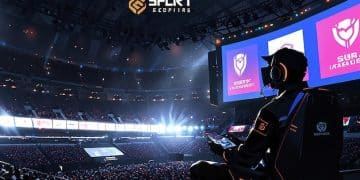US Esports Tournament Team Management: Building a Winning Roster

Effective US esports tournament team management hinges on strategic player acquisition, fostering a cohesive team environment, and implementing robust support structures for sustained competitive success in a dynamic industry.
In the highly competitive world of professional gaming, mastering US esports tournament team management is the critical differentiator between fleeting success and building a lasting legacy. Constructing a roster capable of securing victories demands more than just identifying skilled players; it requires a nuanced understanding of synergy, resilience, and adaptability.
The Foundation: Strategic Player Identification and Scouting
Building a successful esports roster begins with a meticulous and forward-thinking approach to player identification. It’s not simply about raw in-game mechanical skill, but also about the intangible qualities that contribute to team cohesion and performance under pressure.
Beyond Mechanics: What to Look For
While mechanical prowess is undeniably important, a truly effective scouting process delves deeper. Coaches and managers must assess a player’s game sense, their ability to make critical decisions in high-stakes moments, and their understanding of advanced strategies. This involves extensive review of VODs, participation in scrims, and analysis of in-game statistics that go beyond mere kill-death ratios.
- Adaptability: Can the player pivot strategies mid-game or adjust to different meta shifts?
- Communication: Is their in-game communication clear, concise, and impactful?
- Leadership Potential: Do they show qualities that could elevate their teammates?
- Mental Fortitude: How do they react to setbacks, losses, or high-pressure situations?
Identifying emerging talent often requires a wide net, spanning amateur leagues, collegiate esports, and even high-level public ladder play. Data analytics tools are increasingly vital in this process, providing objective metrics that complement subjective observation. The goal is to find players whose individual strengths not only shine but also complement the specific needs and playstyle of the burgeoning team.
The scouting process is continuous. Even after a roster is formed, keeping an eye on new talent or potential upgrades remains a key management responsibility. This proactive stance ensures the team can evolve and maintain its competitive edge as the esports landscape rapidly changes. Understanding how potential recruits fit into the existing team culture is also paramount, as a toxic personality can quickly undermine even the most skilled lineup.
Cultivating Synergy: Team Dynamics and Role Assignment
Once individual talents are identified, the art of team management shifts to forging them into a cohesive unit. Synergy is not an accidental byproduct; it’s a deliberate outcome of thoughtful role assignment, mutual respect, and shared goals.
Defining Roles and Responsibilities
Every successful esports team features clear, defined roles. This extends beyond the game’s official positions to encompass leadership, shot-calling, strategic analysis, and even emotional support. A dedicated in-game leader (IGL) is often crucial, providing direction and making split-second decisions. Other players might specialize in specific in-game functions, like aggressive initiators, supportive anchors, or carry roles.
Effective role assignment considers both a player’s natural tendencies and what the team structure requires. Sometimes, the best player for a particular role isn’t the one with the highest individual statistics, but the one who best fits the team’s overall strategic vision and can enable their teammates to perform optimally. This requires deep understanding of each player’s strengths and weaknesses, not just mechanically, but also their psychological profile.
Beyond individual assignments, fostering strong interpersonal relationships is key. Team-building exercises, both in-game and outside of it, can strengthen bonds and improve communication. Regular, structured feedback sessions where players can openly discuss performance, strategy, and personal issues contribute significantly to a healthy team dynamic and problem-solving capabilities.
The Coaching Staff: Architects of Performance
The role of the coaching staff in esports is multifaceted and increasingly indispensable. They are the strategists, analysts, mentors, and sometimes even the disciplinarians, shaping both individual player development and collective team performance.
Strategic Planning and In-Game Adaptability
A top-tier coaching staff excels at breaking down complex game mechanics, analyzing opponent strategies, and developing comprehensive game plans. This involves extensive review of VODs (video on demand), both of their own team and competitors, to identify patterns, weaknesses, and opportunities. They are responsible for implementing meta shifts, adapting to new patches, and ensuring the team is always ahead of the curve.
- VOD Review Sessions: Detailed analysis of gameplay to pinpoint errors and successes.
- Strategic Blueprinting: Developing pre-game strategies and in-game adjustments.
- Mental Conditioning: Preparing players for the psychological demands of competition.
- Skill Refinement: Providing targeted feedback for individual player improvement.
Beyond tactical knowledge, coaches must possess strong communication skills, capable of relaying complex information clearly and inspiring confidence. They serve as a crucial bridge between players and management, ensuring player needs are met while maintaining professional discipline. The head coach often oversees a broader support system including assistant coaches, analysts, and even sports psychologists, forming a robust structure designed for peak performance.

Holistic Player Welfare: Health, Wellness, and Longevity
In traditional sports, athlete welfare is a given. In esports, it’s still evolving, but increasingly recognized as crucial for player longevity and consistent performance. Neglecting player health, both physical and mental, can lead to burnout, injury, and a premature end to promising careers.
Physical and Mental Health Support
Esports players often spend long hours practicing, leading to potential issues like repetitive strain injuries (RSI), eye strain, and sedentary lifestyle-related health problems. Proactive management includes providing ergonomic setups, encouraging regular physical activity, and ensuring players have access to proper nutrition. Additionally, the immense pressure of competition, public scrutiny, and constant travel can take a toll on mental health. Teams must offer access to sports psychologists, therapists, or counselors to help players manage stress, anxiety, and performance issues.
Player contracts should ideally include clauses that detail health benefits, access to medical professionals, and mental health support. Creating a balanced schedule that incorporates rest days, social activities, and time away from the screens is vital in preventing burnout. A healthy player is a focused and resilient player, capable of performing consistently at the highest level without succumbing to the pressures of the profession. This long-term view on player welfare contributes significantly to the team’s overall stability and success.
Financial Acumen: Budgeting, Contracts, and Sponsorships
Effective team management includes handling the financial realities of professional esports. This involves shrewd budgeting, legally sound contracts, and securing lucrative sponsorship deals to ensure the team’s sustainability and growth. Without a solid financial foundation, even the most talented roster can falter.
Securing Resources for Success
Budgeting in esports is complex, covering salaries, travel expenses, training facilities, equipment, coaching staff, and marketing. Managers must allocate resources strategically, prioritizing investments that directly contribute to competitive advantage and player well-being. This requires a keen eye for cost-efficiency without compromising quality. Contracts with players, coaches, and staff need to be fair, transparent, and legally binding, protecting both the individuals and the organization. This includes clauses related to salary, bonuses, intellectual property, image rights, and dispute resolution mechanisms.
Sponsorships are the lifeblood of most esports organizations. Attracting and retaining sponsors requires a strong brand identity, a successful competitive record, and a clear understanding of what brands seek from partnerships. This could range from in-game branding and social media shout-outs to community engagement events and merchandise collaborations. Building relationships with potential sponsors and demonstrating measurable return on investment is a continuous effort that falls under the purview of effective management.
The financial health of an esports team directly impacts its ability to attract and retain top talent, invest in cutting-edge training, and provide the comprehensive support necessary for a championship-caliber roster. Sustainable financial planning allows teams to weather competitive downturns and capitalize on growth opportunities in the rapidly expanding esports market.

Adaptability and Evolution: Surviving the Esports Meta
The esports landscape is in constant flux. Game metas shift with patches, new titles emerge, and rival teams continuously innovate. A successful team management strategy emphasizes adaptability and a commitment to continuous evolution, ensuring the roster remains relevant and competitive.
Staying Ahead of the Curve
This proactive approach involves several key components. Firstly, a dedicated analytical department or individual responsible for monitoring game updates, anticipating meta changes, and developing new strategies is essential. Secondly, the coaching staff and players must be willing to experiment with new compositions, playstyles, and even roles. A rigid adherence to outdated strategies can quickly lead to decline.
- Data-Driven Analysis: Utilizing performance data to identify areas for improvement and strategic shifts.
- Cross-Game Experience: Exploring if player skills are transferable to new or emerging titles.
- Community Engagement: Staying connected to the broader esports community for emerging trends.
- Roster Flexibility: Being prepared to make roster changes if performance stagnates or roles become obsolete.
Successful US esports tournament team management demands foresight. Predicting the direction of a game, understanding competitor moves, and developing talent pipelines for future roster needs are all part of this. The willingness to iterate, fail fast, and learn quickly is paramount. This dynamic approach ensures the team doesn’t just compete but also sets trends, adapting to the ever-shifting competitive landscape and consistently fielding a top-tier roster prepared for any challenge.
Building a Brand: Marketing, Content, and Fan Engagement
Beyond competitive success, a well-managed esports team understands the importance of building a recognizable brand. This involves strategic marketing, consistent content creation, and active fan engagement, all of which contribute to revenue generation, sponsor appeal, and long-term viability.
Connecting with the Audience
In the digital age, esports engagement extends far beyond tournament viewership. Teams must cultivate a strong online presence through social media, streaming platforms, and dedicated content channels. This includes producing behind-the-scenes vlogs, player spotlights, strategic breakdowns, and lifestyle content that humanizes the players and strengthens fan connections. A compelling brand narrative helps differentiate the team in a crowded market.
Engaging with the fanbase fosters loyalty and creates a vibrant community. This can take many forms: Q&A sessions with players, fan art contests, watch parties, and even direct interaction on platforms like Twitch and Discord. Strong fan engagement translates into merchandise sales, increased viewership for streams and tournaments, and greater appeal to potential sponsors looking for an active and dedicated audience. Ultimately, a powerful brand magnifies the team’s reach and financial opportunities, making it attractive to top talent and investors alike.
Legal and Ethical Framework: Ensuring Fair Play and Integrity
The burgeoning esports industry, while exciting, is not immune to legal and ethical challenges. Robust team management necessitates a clear framework to ensure fair play, protect players, and uphold the integrity of the sport. This includes navigating complex contractual agreements, anti-doping policies, and intellectual property rights.
Adhering to Professional Standards
Professional esports teams operate within a web of regulations set by tournament organizers, game developers, and national governing bodies. Compliance with these rules is non-negotiable. This encompasses everything from competitive integrity rules, such as anti-cheating and anti-match-fixing measures, to player conduct codes designed to maintain a respectful and competitive environment. Ethical considerations extend to talent scouting, ensuring fair treatment of amateur players, and avoiding predatory practices.
- Contractual Compliance: Ensuring all agreements (player, sponsor, staff) meet legal standards.
- Anti-Doping Policies: Educating players and enforcing compliance with performance-enhancing drug rules.
- Safeguarding Player Rights: Protecting player image rights, intellectual property, and privacy.
- Dispute Resolution: Establishing clear procedures for handling conflicts and grievances.
A proactive legal and ethical approach safeguards the team’s reputation, protects its players from exploitation, and contributes to the overall legitimacy and growth of esports. Managers must stay abreast of evolving legal precedents and industry best practices, often consulting with legal professionals specialized in sports law. Maintaining impeccable ethical standards is not just about avoiding penalties; it’s about building a respected and trustworthy organization that attracts the best talent and the most valued partners, ensuring long-term success and positive influence within the ecosystem.
| Key Aspect | Brief Description |
|---|---|
| 🔍 Player Scouting | Identify talent beyond mechanics; focus on adaptability, communication, and mental resilience. |
| 🤝 Team Synergy | Define roles, foster strong relationships, and ensure clear communication for cohesion. |
| 🧠 Coaching & Support | Provide expert strategic guidance, VOD analysis, and mental health support. |
| 💰 Financial Stability | Strategic budgeting, fair contracts, and securing sponsorships are vital for growth. |
Frequently Asked Questions
▼
The most crucial aspect is identifying players who not only possess high mechanical skill but also exhibit strong communication, adaptability, and mental resilience. Building synergy and a supportive environment among these individuals is paramount for long-term success, as raw talent alone often isn’t enough in high-pressure tournament settings.
▼
A dedicated coaching staff is extremely important, serving as the strategic backbone of the team. They provide in-depth game analysis, develop tactical plans, conduct VOD reviews, and offer mental conditioning. Their expertise helps players refine skills, adapt to game changes, and maintain peak performance under stress, filling a gap individual players often cannot.
▼
Player welfare is increasingly vital for longevity and consistent performance. It includes providing ergonomic setups, promoting physical activity, ensuring proper nutrition, and offering mental health support. Addressing burnout, stress, and physical strain helps players sustain their careers and allows teams to retain top talent, contributing to overall stability.
▼
Esports teams secure funding primarily through strategic budgeting, lucrative sponsorship deals, and merchandise sales. Effective financial management involves allocating resources wisely across salaries, facilities, and travel. Transparent contracts with players and staff also build trust, while a strong brand identity attracts and retains the corporate partners essential for sustained operation and growth in the competitive market.
▼
Adaptability is crucial because the esports landscape evolves rapidly with game updates, meta shifts, and new competitors. Teams must constantly analyze data, experiment with new strategies, and be willing to evolve their playstyles or even roster compositions. Remaining flexible ensures the team stays relevant, competitive, and can maintain a leading edge against innovative rivals.
Conclusion
Mastering US esports tournament team management is an intricate blend of art and science, demanding acute insight into talent, nuanced understanding of team dynamics, and robust operational execution. From the initial strategic scouting that identifies not just skilled players, but synergistic personalities, to cultivating an environment of holistic player welfare, every decision contributes to the collective strength. The unseen efforts of dedicated coaching staffs, diligent financial strategists, and meticulous brand builders cement a team’s foundation. In an industry defined by relentless innovation and fierce competition, sustained success hinges on proactive adaptability, ethical standards, and a deep, continuous investment in both the individual and the collective. Building a winning roster is an ongoing journey of refinement and evolution, promising both formidable challenges and unparalleled rewards.





